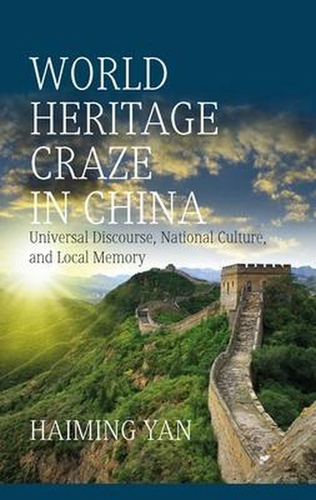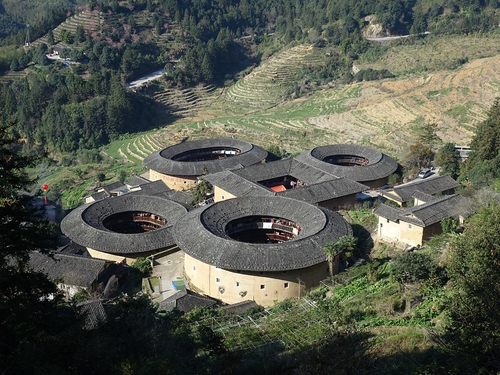Blog Books
Book: World Heritage Craze in China
This is the second fairly recent book about WHS in China, after Chinese Heritage Sites and their Audiences by Rouran Zhang (2020) which I reviewed earlier. 'World Heritage Craze in China' was originally published in 2018 and is written by Haiming Yan - born in China, got his Ph.D. in Sociology from a university in the USA, and now is the director of the secretariat of ICOMOS China. The central question he tries to answer in this book is: Why is World Heritage so important for the Chinese?

The role of the State
The author mostly focuses on the role the central government plays in the nomination and management of World Heritage in China. He clearly is comfortable with Chinese laws, governmental organizations, and bureaucracy. Like Zhang, he underlines the importance of China having integrally adopted the World Heritage model of heritage conservation (as a framework with its tools and vocabulary), as it did not have one of its own before. They don't feel awkward about this copying, as a Chinese saying says "a stone from other hills may serve to polish the jade of this one". Also, because the Chinese became so well-versed in the WH lingo, they tend to write excellent nomination dossiers.
What does the Chinese government expect to gain from it? The objectives are both international and domestic:
- Quantity is important: having the highest number of WHS would reflect China's actual resources.
- Present a unified nation and historical continuity. This is especially visible in the Chengde and Lhasa narratives (showing multiculturalism, but thereby also their inseparable belonging to the unified nation), and also in 'The Grand Canal' which never was constructed as a single integrated canal.
- Give a 'sense of belonging' to newly reunified regions (Macao's nomination was fast-tracked after its incorporation in 1999).
Three Case Studies
The WHS of Fujian Tulou, Dengfeng, and the Great Wall each have their own chapter, highlighting the role of the State versus other (mostly local) actors during the nomination process and thereafter.
Fujian Tulou presents a tale of disharmony between the two actors. Right after the inscription, there were protests by the inhabitants of the tulou in Tianluokeng (pictured below) in order to receive a higher percentage of the ticket income. Some villages were included in the WHS and others while similar were not, which lead to diverging economical paths. The state interference even involves yearly sending government officials to instruct the locals how to live in a way that fits with the protective status of their residences.
Dengfeng: this was the first Chinese site ever to have been given a negative ICOMOS evaluation (Referral), and it was seen as a total failure. ICOMOS couldn't really understand why Mt. Songshan was listed on the Tentative List twice (once on its own and once as part of Five Sacred Mountains), which also reflected different views between the Chinese governmental organizations responsible for cultural nominations and those for natural/mixed. They did manage to turn it around by changing the site name and the narrative fully from 'sacred mountain' to 'center of cosmology', and shifting the focus from the mountain to the city. Here also not only the inscription narrative has changed, but also the story presented 'on the ground' has made a matching turn. The legendary figure who once in publications was described as the 'monk Yi Xing', now is identified as an astronomical scholar.
Great Wall: used as an example of 'the World' versus the Chinese nation. Although the concept of the 'Great Wall' as a single great wall even was constructed by western writers and the structure is recognized globally, the Chinese do see it as their own and don't appreciate interference. It is marketed nowadays as a symbol of international friendship, especially the Badaling section.

Conclusion
According to Haiming Yan, World Heritage is important to 'the Chinese' (the Chinese authorities mainly) because it reinforces national identity and nationalism. By embracing a global model - seen as scientific and impartial - it gets exogenous appreciation which legitimizes China as a sovereign nation. In the way he describes the dealings of the Chinese officials with ICOMOS and the WHC, they also come across as overachieving students.
It's also an instrument in 'Heritage enlightenment' - the spread of heritage preservation among the people, as it is both modern and patriotic and requires behavioral discipline. Indeed what surprised me the most while reading this book is that the Chinese really follow through on the ground - they're not satisfied with 'We are WHS, who cares how we got there, let's reap the profits'.
The book is fairly similar to the one by Zhang. Both are Ph.D. theses turned into books, so they cling to a certain pattern necessary for the thesis and are not eloquent works of popular science. He doesn't go much into the value of tourism WH status brings, which I find is an omission as domestic tourism is huge in China.
Els - 26 March 2023
Comments
Els Slots 26 March 2023
No it does not. It is actually the weakest described case.
Solivagant 26 March 2023
Re Great Wall..... Does it address the issue of how much/little of the GW is actually inscribed... And the current circumstance (whatever that might be) is regarded..